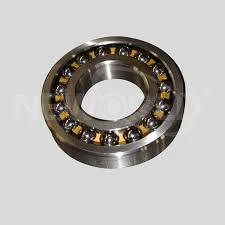
Nov . 17, 2024 22:57 Back to list
NU 208 Bearing Specifications and Applications for Optimal Performance and Reliability
Understanding Bearings A Focus on NU 208
Bearings are critical components in machinery, playing a crucial role in facilitating movement and reducing friction between moving parts. Among various types of bearings, cylindrical roller bearings are significant for their capacity to handle heavy loads and endure high speeds. In this discussion, we will focus specifically on the NU 208 cylindrical roller bearing, exploring its design, applications, and benefits.
Design and Structure
The NU 208 bearing belongs to the NU series of cylindrical roller bearings, characterized by its unique design that incorporates rollers in a cylindrical shape. This allows for enhanced load distribution and minimal friction, which leads to smoother operation. The NU 208 features a single row of rollers, housed within an inner and outer ring. The roller design provides higher radial load capacity compared to ball bearings, making it suitable for high-load applications.
One of the defining features of the NU 208 is its cage design, which maintains proper spacing of the rollers and prevents them from coming into contact with each other during operation. This design not only reduces wear but also helps in maintaining consistent performance under varying operational conditions. Additionally, NU 208 bearings are usually made from high-quality steel, which enhances their durability and longevity.
Understanding Bearings A Focus on NU 208
The NU 208 bearing finds use in various applications across multiple industries. Its robust construction makes it ideal for heavy machinery, automotive applications, and industrial equipment. Common applications include hydraulic pumps, gearboxes, and electric motors where high radial loads are present. The ability to accommodate axial displacement in both directions also makes it favorable for applications where thermal expansion may occur.
bearing nu 208

Furthermore, the NU 208 is often employed in the manufacturing of machinery that demands precision and reliability. The automotive industry, for example, utilizes this type of bearing in transmissions and axle assemblies, where they withstand substantial operational stresses. In the agricultural sector, these bearings are used in equipment such as tractors and combines, ensuring efficient operation in rugged environments.
Advantages
The use of NU 208 bearings offers several advantages. First and foremost, their ability to handle high loads while maintaining low friction translates into improved energy efficiency. This efficiency can result in lower operating temperatures, ultimately contributing to the bearing's longevity. Additionally, the NU 208's design allows it to perform well under both dynamic and static loads, making it a versatile choice for diverse applications.
Another benefit is their ease of maintenance and replacement. The standardization of sizes means that users can find replacement bearings readily available in the market, reducing downtime and maintenance costs. With proper lubrication and maintenance, NU 208 bearings can provide reliable performance over an extended service life.
Conclusion
In summary, the NU 208 cylindrical roller bearing is an essential component in various machinery and applications. Its robust design, combined with its capacity to handle high loads and provide low friction, makes it an optimal choice for industries that rely on precision equipment. As machinery continues to evolve and demand greater reliability, the importance of high-quality bearings like the NU 208 will undoubtedly grow. Understanding the capabilities and applications of such bearings provides insights into how they contribute to the efficiency and longevity of industrial operations.
Latest news
-
Grooved Ball Bearing Design and Functionality
NewsJun.04,2025
-
Concrete Mixer Bearing Load Capacity Testing
NewsJun.04,2025
-
6004 Bearing Dimensions in Robotic Joint Designs
NewsJun.04,2025
-
Advantages of Single-Row Deep Groove Ball Bearings
NewsJun.04,2025
-
Applications of Deep Groove Ball Bearings in Automotive Systems
NewsJun.04,2025
-
Innovations in Bearing Pressing Machine Design
NewsJun.04,2025
